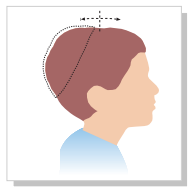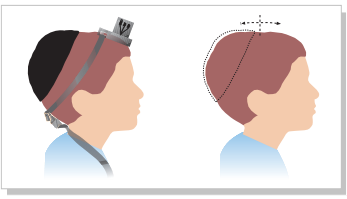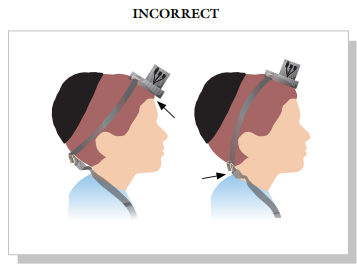Chapter 26: Donning the Tefillin Shel Rosh
1) After one wraps the tefillin shel yad seven times around his forearm, he should stand and don the tefillin shel rosh, without reciting a berachah.[140]
2) When one handles the tefillin shel rosh in preparation for putting it on one’s head, he should preferably hold the box and the knot together. One may, however, momentarily hold only the knot or only the box as he prepares to place the tefillin on his head.
3) The tefillin shel rosh must be placed within the area from the front hairline until the end of the spot on the head that

is soft during infancy, which is located along the top surface of the head. The tefillin should be positioned directly parallel to the area in between the eyes.[141]
4) Preferably, one should wear the tefillin no further back than the halfway point from the hairline to the peak of the

head. To that end, one should ensure not to wear very large tefillin.[142]
5) Unfortunately, many people mistakenly assume that the tefillin may be worn until the ends of the hair in the front of the head, and thus wear tefillin on the upper part of the forehead. This is incorrect; the tefillin may be worn only

until the root of the front hair, and must therefore be placed on the top of the head, and not on the forehead. Preferably, they should be worn slightly above the root of the front hair so that they won’t fall down onto the forehead. People who wear the tefillin shel rosh on their forehead, beyond the root of the front hair, do not fulfill their obligation.[143]
6) If the tefillin slips down onto one’s forehead he should immediately return it to its proper place. If the tefillin shel rosh repeatedly falls lower than the hairline, it is likely that the strap needs to be adjusted and shortened.[144]
7) Those who are bald or whose hairline has receded should place the tefillin shel rosh until the place of the original hairline, even though there is currently no hair at that spot.[145]
8) As mentioned above, the bayit of the tefillin shel rosh must be positioned on the area on the head that corresponds to the area between the eyes.

Otherwise, according to many authorities, one does not fulfill the obligation of tefillin. It is permissible to use a mirror to ensure that the tefillin shel rosh is properly positioned.[146]
9) The knot of the tefillin shel rosh should be positioned in the back of the head, at the bottom of the skull, parallel to the

face, rather than parallel to the throat. It should be situated squarely in the middle of the back of the head, and not off to the side [147]

a. One should endeavor to position the tefillin such that the majority of the knot is situated just above the indentation below the skull. At very least, one must ensure that no part of the knot should be below the hair.[148]
b. One must ensure that the strap of the tefillin shel rosh is adjusted in accordance with the size of his head so that when the bayit and knot are positioned in their proper places, the tefillin is tightly fastened around the head.

The mitzvah of tefillin requires that the tefillin be securely tied to the head, and not be loosely placed on the head, and, additionally, if the tefillin is not wrapped tightly around the head, the bayit or knot will likely move from its proper place. Therefore, one who borrows tefillin must ensure to adjust the straps to accommodate the size of his head.[149]
c. One who wears a hat during the prayer service must pay particular attention to ensure that the hat does not move the tefillin from its place.[150]
10) After one finishes placing the tefillin shel rosh on his head, he should remain standing and wrap the strap of the tefillin shel yad around his middle finger, as discussed more fully in the section entitled “Wrapping the Strap of the Shel Yad Around the Middle Finger.”
11) There are divergent views as to whether the tefillin shel rosh should be exposed or covered by the tallit. Most authorities maintain that it should be exposed, as suggested in the verse, 'וראו כל עמי הארץ כי שם ה נקרא עליך (“All nations on earth shall see that the name of Hashem is called upon you” — Devarim 28:10), which refers to tefillin shel rosh. The Arizal, however, held that one should cover the tefillin shel rosh with the tallit.[151]
Footnotes
- 140 - שו"ע כה:יא ועיין כה"ח כה:ה שהביא דעת המקובלים שקודם שיניח התש"ר יסתכל בשני השי"נין אשר על התש"ר. ויסתכל קודם בשי"ן של ד'ראשין ואח"כ יסתכל בשי"ן של ג' ראשין
- 141 - שו"ע כז:כ
- 142 - שו"ע כז:ט וכה"ח שם, ילקוט יוסף
- 143 - משנ"ב כז:ט וכה"ח שם
- 144 - משנ"ב וכה"ח שם
- 145 - כה"ח שם
- 146 - שו"ע כז:י ומשנ"ב שם, ילקוט יוסף
- 147 - שו"ע כז:י ומשנ"ב שם
- 148 - משנ"ב שם
- 149 - משנ"ב שם
- 150 - כה"ח שם
- 151 - שו"ע כז:יא וכה"ח

